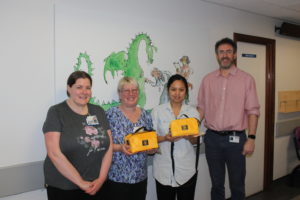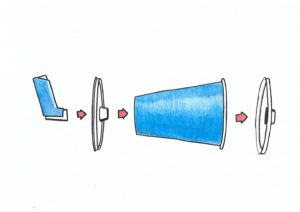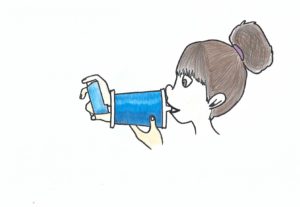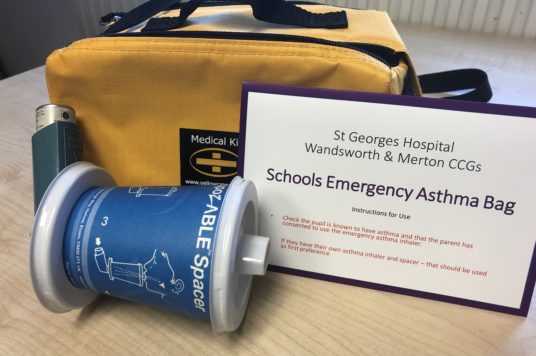St George’s rolls out London’s first asthma bag scheme to local schools
St George’s is rolling out a new scheme to provide every primary and secondary school with an emergency asthma kit, which is believed to be the first initiative of its kind in London.
The scheme, which is in conjunction with the Wandsworth and Merton Children’s Asthma Board, was devised to ensure that all state schools in Wandsworth and Merton have an emergency asthma kit available in line with the Department of Health guidelines and as part of a drive to improve asthma awareness and education.
Asthma affects approximately 1 in 11 children. Acute asthma attacks are one of the most common reasons that children have to attend, or are admitted to, hospital – many of which start or occur while a child is at school.
Whilst families are advised to provide schools with an asthma management plan and suitable inhalers and spacers, this may not always be available.

From left: Sarah Hawkins, Asthma Nurse Specialist; Jo Lawson and Camille Valencia, Clinical Nurse Specialists; and Dr Richard Chavasse, Consultant in Paediatric Respiratory Medicine with the asthma bags
Dr Richard Chavasse, Consultant in Paediatric Respiratory Medicine at St George’s and Project Lead, said: “We hope that through this scheme, schools will be better placed to give prompt help to children at school which may prevent a more serious asthma attack. This may reduce the number of children needing to attend hospital as an emergency. Secondly, by using this scheme to raise awareness of asthma, its symptoms and treatments in schools there will be additional benefits for the many children with asthma, reducing its impact on their education and wellbeing.”
The emergency asthma bag contains an inhaler, disposable spacers and an illustrated instruction card. There is also documentation for schools to keep updated. The bags have been funded by Wandsworth CCG, designed by Dr Chavasse and assembled through St George’s Pharmacy.
Over the next few months, every state primary and secondary school in Wandsworth and Merton will receive a bag and training. The emergency inhaler will be used in conjunction with the individual child’s asthma plan, if their own inhaler cannot be used, with consent from the parents.


Dr Chavasse is urging children with asthma and their families to learn more about the condition to enable them to manage it more effectively by knowing the signals. Such education includes using an asthma plan emphasising how, why and when their asthma medications should be taken and how to recognise and respond to an asthma attack, including when emergency care is required.
Dr Chavasse said: “These emergency asthma bags are designed to include everything that would be needed if a child has an asthma attack at school. There is a simple instruction guide that comes with the bag. We hope to educate at the same time, to enable children, teachers and parents to be more involved and understanding of asthma.”
Notes to editors
More information about asthma:
Asthma attacks are often triggered by viral infections developing over a period of hours or days and take a number of days to resolve. Other triggers include exercise, allergies and stress. Symptoms include: difficulty breathing, a wheezing sound coming from the chest, frequent cough, shortness of breath or tightness of the chest. Children may be unable to complete sentences when speaking.
Children with asthma may have a regular preventer inhaler which should be taken every day to control their asthma. They should also have a reliever inhaler to take if they develop symptoms. Children should use a spacer device when using ‘pump’ style inhaler. They should always be taught how to use their inhalers/spacers correctly.
If a child having an asthma attack is not responding to treatment or they appear exhausted or confused, turning blue or has a blue/white tinge around their lips or they have collapsed, an emergency 999 ambulance must be called immediately.
Contact:
For more information, please contact Pippa Harper, Media Manager at St George’s
philippa.harper@stgeorges.nhs.uk or 020 8266 6128.


